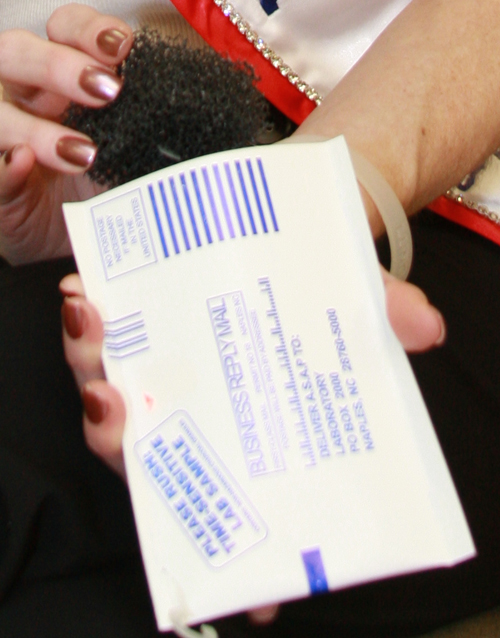Radon is tasteless, odorless and invisible, but the radioactive gas still kills more Americans every year than drunk driving. It is the most common cause of lung cancer among non-smokers and causes about 21,000 deaths a year.
Those statistics have left one Athens, Ga., family wondering if radon contributed to the premature death of their 27-year-old daughter. They’re urging other Georgia families to have their homes tested for the gas, which seeps up from the state’s granite bedrock and may reach unsafe levels as it accumulates in the home.
“Radon tests are very inexpensive, and it’s no trouble whatsoever,” said Ann Tackett, who lives in Athens and recently lost her daughter. “Just see if your house has radon. If it does, get it fixed.”
Tackett’s daughter died in late November after being diagnosed with lung cancer in fall of 2011. She had never smoked.
January is National Radon Action month, and the Tacketts and University of Georgia Cooperative Extension home safety and public health educators are asking Georgians to minimize their families’ exposure to the silent killer.
Radon is a naturally occurring gas that seeps from the ground as uranium deposits decay. It is always in the ambient air, usually at about 0.4 picocuries per liter (pCi/L).
At that level, radon is not harmful, but over time the radioactive gas can become concentrated in the air inside homes. The U.S. Environmental Protection Agency considers levels of 4 pCi/L or more as high. Of course, the lower the radon level, the better.
In the last year of her life, Allison made it her mission to educate the public about the dangers of radon gas and what they can do to keep their families safe. Now her mother has taken over that task, making sure her neighbors have their homes tested and speaking out whenever and wherever she can.
“I’m going to try to fill those huge shoes,” said Tackett, who had never heard of the dangers posed by household radon until one of her daughter’s doctors suggested that she have the house tested.
While homes in every part of Georgia are at risk for radon infiltration, homes in north Georgia are especially vulnerable. Gwinnett, Cobb, Fulton and DeKalb counties have the highest average indoor radon levels, according to the EPA.
The UGA Cooperative Extension Radon Education Program works across the state to bring awareness, but educators target counties n the northern third of Georgia where most of the high radon levels are found, said radon educator Becky Chenhall. This year about 4,400 students and adults participated in radon awareness workshops and presentations.
Radon testing is cheap and easy. Families can purchase a kit for $8 from their county Extension office or for $10 online at www.ugaradon.org. Test kits may also be purchased from local retailers. The advantages of purchasing a kit from UGA are that the cost includes the lab analysis and a follow up from a UGA radon educator if your test results are high.
Test kit instructions should be followed exactly, but homeowners typically hang the carbon filled test canister in their house for between three to seven days before mailing it to a testing center.
The air inside the average home contains about 1.3 pCi/L of radon. Experts recommend mitigation, which involves installing a ventilation system, for any home that has 4 pCi/L or above.
Tests revealed the Tacketts were living with a radon level of 3.1 pCi/L in their home. They plan to install a ventilation system that diverts radon from under the house through a vent pipe to the outside air above the roof, thus, preventing radon gas from entering the home.
The Tacketts’ story is not unusual, Chenhall said. In the decade since she started doing radon awareness work, she has met several families who didn’t know their homes were unsafe until a loved was diagnosed with lung cancer.
When she first started educating people about the risks of radon, people had never heard of the gas. Today, people seem to know that radon poses a risk to their families, but many still put off testing their homes.
“I think part of the reason is that you don’t see the effects for so long,” Chenhall said. “It can take at least 12 to 14 years for radon to start causing problems.”
Other families are worried they won’t have the money to install the needed the ventilation system if they find that their homes have high levels of radon, she said.
“In reality, the improvements are not that expensive given that the device has the potential to save lives, and if you need a radon mitigation system, the first step involves planning and saving,” Chenhall said.
In the first three quarters of 2012, the UGA Radon Education Program distributed 1,649 radon test kits. Almost 380 families found unsafe radon levels in their homes, and about half were able to get the problem fixed this year.
A video tutorial on how to conduct a radon test can be viewed on the UGA College of Family and Consumer Sciences Extension’s website at www.ugaradon.org.
For more information about radon visit the UGA website at www.ugaradon.org, the EPA website at www.epa.gov/radon/ and watch a video at www.youtube.com/user/UGAGreenWay.









